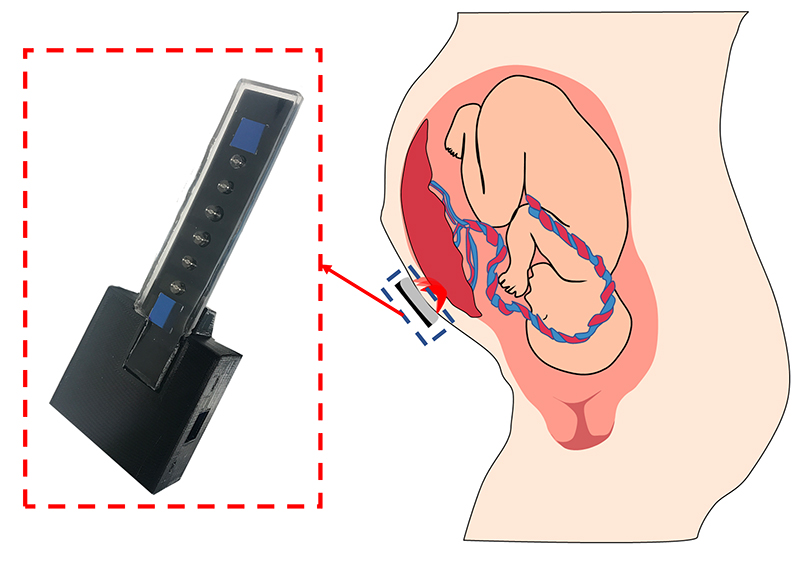NIH researchers pursue innovative method for observing maternal and fetal health during pregnancy

Credit: Thien Nguyen, Ph.D., Post Doctoral Fellow, Section on Translational Biophotonics, Eunice Kennedy Shriver National Institute of Child Health and Human Development, NIH
WHAT:
Researchers at the National Institutes of Health have developed a prototype device that could potentially diagnose pregnancy complications by monitoring the oxygen level of the placenta. The device sends near-infrared light through the pregnant woman’s abdomen to measure oxygen levels in the arterial and venous network in the placenta. The method was used to study anterior placenta, which is attached to the front wall of the uterus. The researchers described their results as promising but added that further study is needed before the device could be used routinely.
The small study was conducted by Amir Gandjbakhche, Ph.D., of the Section on Translational Biophotonics at NIH’s Eunice Kennedy Shriver National Institute of Child Health and Human Development (NICHD), and colleagues. It appears in Biomedical Optics Express. The study was funded by NICHD’s Human Placenta Project and Division of Intramural Research.
The researchers devised mathematical methods to study the passage of light through the skin, abdominal wall and uterine tissue to reach the placenta and calculate its oxygen levels. Currently, the device cannot monitor oxygen in women with a posterior placenta, which is attached to the back wall of the uterus, because the distance is too far for the light to travel. However, anterior placenta is associated with a higher rate of complications than posterior placenta, such as postpartum hemorrhage and an increased need for labor induction or cesarean delivery.
The researchers enrolled 12 pregnant women with an anterior placenta in the study. Of these, five had a pregnancy complication, including hypertension, a short cervix and polyhydramnios (excess amniotic fluid). On average, the women with complications had a placental oxygen level of 69.6%, a difference statistically significant from the 75.3% seen in the healthy pregnancies in the study. The authors see their results as a first step in continuously monitoring placental oxygen levels to assess maternal and fetal health.
WHO:
Amir Gandjbakhche, Ph.D., of the NICHD Section on Translational Biophotonics, is available for comment.
ARTICLE:
Nguyen, T. Non-invasive transabdominal measurement of placental oxygenation: a step toward continuous monitoring. Biomedical Optics Express.2021. https://doi.org/10.1364/BOE.424969
###
About the Eunice Kennedy Shriver National Institute of Child Health and Human Development (NICHD): NICHD leads research and training to understand human development, improve reproductive health, enhance the lives of children and adolescents, and optimize abilities for all. For more information, visit https://www.nichd.nih.gov.
About the National Institutes of Health (NIH): NIH, the nation's medical research agency, includes 27 Institutes and Centers and is a component of the U.S. Department of Health and Human Services. NIH is the primary federal agency conducting and supporting basic, clinical, and translational medical research, and is investigating the causes, treatments, and cures for both common and rare diseases. For more information about NIH and its programs, visit https://www.nih.gov.

 BACK TO TOP
BACK TO TOP